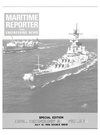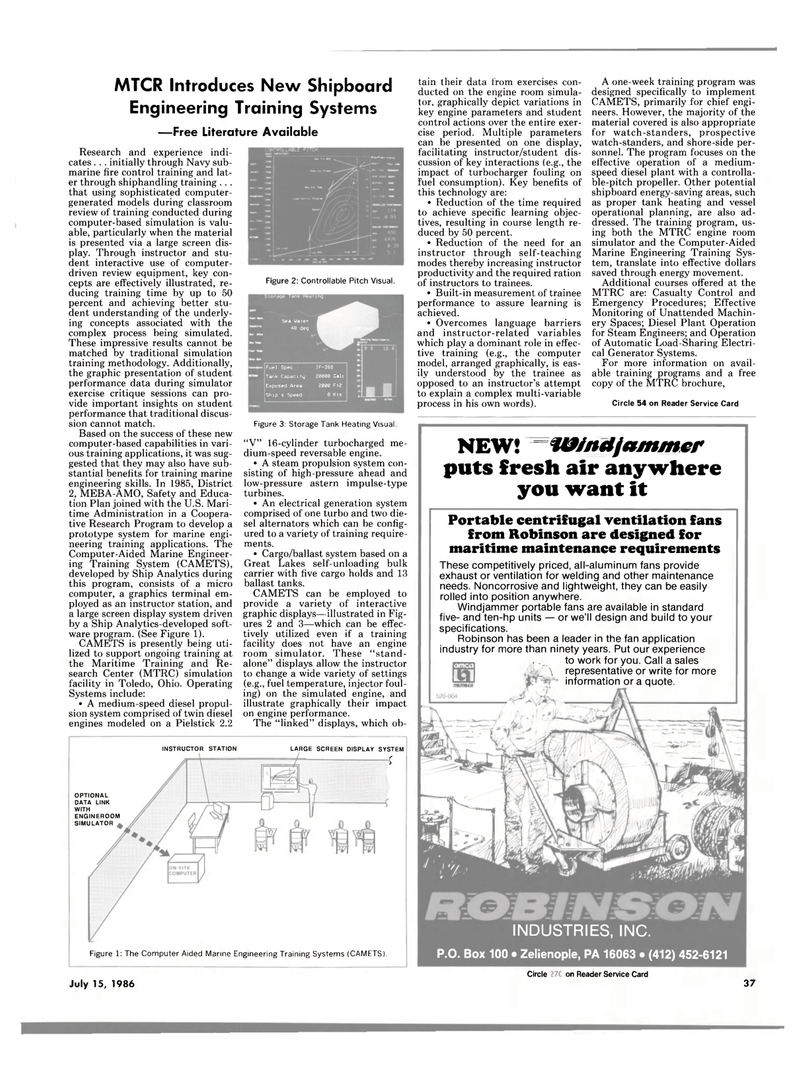
Page 37: of Maritime Reporter Magazine (July 15, 1986)
Read this page in Pdf, Flash or Html5 edition of July 15, 1986 Maritime Reporter Magazine
MTCR Introduces New Shipboard
Engineering Training Systems —Free Literature Available
Research and experience indi- cates .. . initially through Navy sub- marine fire control training and lat- er through shiphandling training . . . that using sophisticated computer- generated models during classroom review of training conducted during computer-based simulation is valu- able, particularly when the material is presented via a large screen dis- play. Through instructor and stu- dent interactive use of computer- driven review equipment, key con- cepts are effectively illustrated, re- ducing training time by up to 50 percent and achieving better stu- dent understanding of the underly- ing concepts associated with the complex process being simulated.
These impressive results cannot be matched by traditional simulation training methodology. Additionally, the graphic presentation of student performance data during simulator exercise critique sessions can pro- vide important insights on student performance that traditional discus- sion cannot match.
Based on the success of these new computer-based capabilities in vari- ous training applications, it was sug- gested that they may also have sub- stantial benefits for training marine engineering skills. In 1985, District 2, MEBA-AMO, Safety and Educa- tion Plan joined with the U.S. Mari- time Administration in a Coopera- tive Research Program to develop a prototype system for marine engi- neering training applications. The
Computer-Aided Marine Engineer- ing Training System (CAMETS), developed by Ship Analytics during this program, consists of a micro computer, a graphics terminal em- ployed as an instructor station, and a large screen display system driven by a Ship Analytics-developed soft- ware program. (See Figure 1).
CAMETS is presently being uti- lized to support ongoing training at the Maritime Training and Re- search Center (MTRC) simulation facility in Toledo, Ohio. Operating
Systems include: • A medium-speed diesel propul- sion system comprised of twin diesel engines modeled on a Pielstick 2.2
Figure 2: Controllable Pitch Visual.
Sea Water 40 deq
Fuel Spec IF-3SB
Tank Capacity aeeee G»1I
Exposed ftrea aeee Fte
Ship's Speed e Kts
INSTRUCTOR STATION
OPTIONAL
DATA LINK
WITH
ENGINEROOM
SIMULATOR
LARGE SCREEN DISPLAY SYSTEM <
Figure 1: The Computer Aided Marine Engineering Training Systems (CAMETS). tain their data from exercises con- ducted on the engine room simula- tor, graphically depict variations in key engine parameters and student control actions over the entire exer- cise period. Multiple parameters can be presented on one display, facilitating instructor/student dis- cussion of key interactions (e.g., the impact of turbocharger fouling on fuel consumption). Key benefits of this technology are: • Reduction of the time required to achieve specific learning objec- tives, resulting in course length re- duced by 50 percent. • Reduction of the need for an instructor through self-teaching modes thereby increasing instructor productivity and the required ration of instructors to trainees. • Built-in measurement of trainee performance to assure learning is achieved. • Overcomes language barriers and instructor-related variables which play a dominant role in effec- tive training (e.g., the computer model, arranged graphically, is eas- ily understood by the trainee as opposed to an instructor's attempt to explain a complex multi-variable process in his own words).
A one-week training program was designed specifically to implement
CAMETS, primarily for chief engi- neers. However, the majority of the material covered is also appropriate for watch-standers, prospective watch-standers, and shore-side per- sonnel. The program focuses on the effective operation of a medium- speed diesel plant with a controlla- ble-pitch propeller. Other potential shipboard energy-saving areas, such as proper tank heating and vessel operational planning, are also ad- dressed. The training program, us- ing both the MTRC engine room simulator and the Computer-Aided
Marine Engineering Training Sys- tem, translate into effective dollars saved through energy movement.
Additional courses offered at the
MTRC are: Casualty Control and
Emergency Procedures; Effective
Monitoring of Unattended Machin- ery Spaces; Diesel Plant Operation for Steam Engineers; and Operation of Automatic Load-Sharing Electri- cal Generator Systems.
For more information on avail- able training programs and a free copy of the MTRC brochure,
Circle 54 on Reader Service Card
Figure 3: Storage Tank Heating Visual. "V" 16-cylinder turbocharged me- dium-speed reversable engine. • A steam propulsion system con- sisting of high-pressure ahead and low-pressure astern impulse-type turbines. • An electrical generation system comprised of one turbo and two die- sel alternators which can be config- ured to a variety of training require- ments. • Cargo/ballast system based on a
Great Lakes self-unloading bulk carrier with five cargo holds and 13 ballast tanks.
CAMETS can be employed to provide a variety of interactive graphic displays—illustrated in Fig- ures 2 and 3—which can be effec- tively utilized even if a training facility does not have an engine room simulator. These "stand- alone" displays allow the instructor to change a wide variety of settings (e.g., fuel temperature, injector foul- ing) on the simulated engine, and illustrate graphically their impact on engine performance.
The "linked" displays, which ob-
NEW! Windjammer puts fresh air anywhere you want it
Portable centrifugal ventilation fans from Robinson are designed for maritime maintenance requirements
These competitively priced, all-aluminum fans provide exhaust or ventilation for welding and other maintenance needs. Noncorrosive and lightweight, they can be easily rolled into position anywhere.
Windjammer portable fans are available in standard five- and ten-hp units — or we'll design and build to your specifications.
Robinson has been a leader in the fan application industry for more than ninety years. Put our experience , to work for you. Call a sales \ representative or write for more information or a quote.
INDUSTRIES, INC.
P.O. Box 100 • Zelienople, PA 16063 • (412) 452-6121
July 15, 1986
Circle 135 on Reader Service Card 37

 36
36

 38
38
